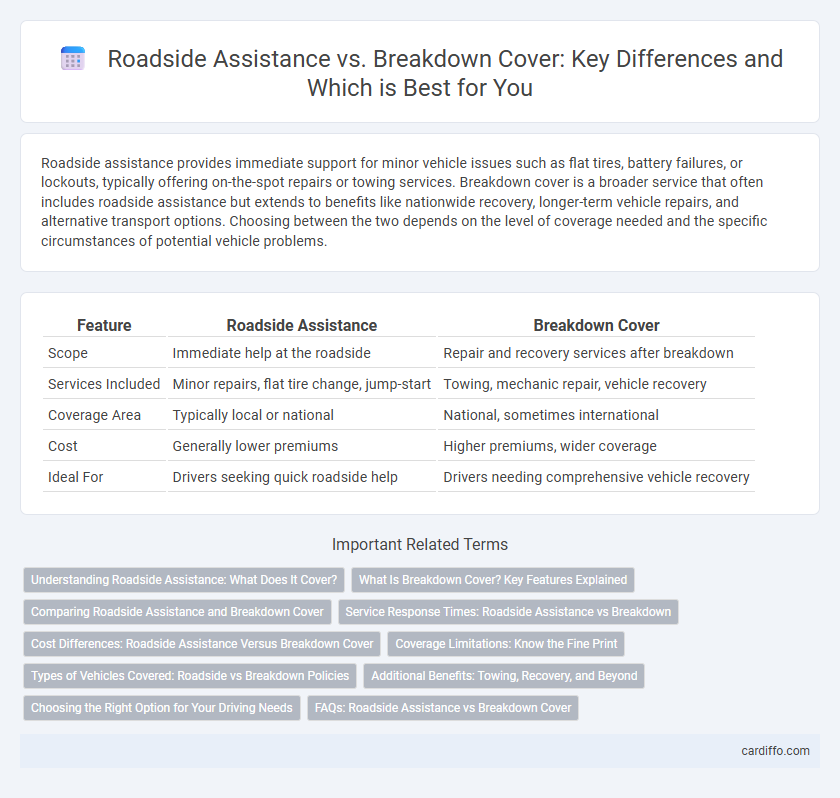Roadside assistance provides immediate support for minor vehicle issues such as flat tires, battery failures, or lockouts, typically offering on-the-spot repairs or towing services. Breakdown cover is a broader service that often includes roadside assistance but extends to benefits like nationwide recovery, longer-term vehicle repairs, and alternative transport options. Choosing between the two depends on the level of coverage needed and the specific circumstances of potential vehicle problems.
Table of Comparison
| Feature | Roadside Assistance | Breakdown Cover |
|---|---|---|
| Scope | Immediate help at the roadside | Repair and recovery services after breakdown |
| Services Included | Minor repairs, flat tire change, jump-start | Towing, mechanic repair, vehicle recovery |
| Coverage Area | Typically local or national | National, sometimes international |
| Cost | Generally lower premiums | Higher premiums, wider coverage |
| Ideal For | Drivers seeking quick roadside help | Drivers needing comprehensive vehicle recovery |
Understanding Roadside Assistance: What Does It Cover?
Roadside assistance typically covers immediate help such as towing, battery jump-starts, flat tire changes, fuel delivery, and lockout services at the location of the breakdown. It is designed to get drivers back on the road quickly without extensive repairs, catering specifically to emergencies occurring roadside. Unlike comprehensive breakdown cover, roadside assistance often excludes recovery to a garage or prolonged vehicle repairs.
What Is Breakdown Cover? Key Features Explained
Breakdown cover provides comprehensive roadside assistance and recovery services when your vehicle suffers a mechanical failure or breakdown. Key features include emergency repairs at the roadside, vehicle recovery to a garage if repairs cannot be made on-site, and options for home start, which covers breakdowns occurring at or near your home. Policies often offer additional benefits such as onward travel, alternative transportation, and nationwide coverage.
Comparing Roadside Assistance and Breakdown Cover
Roadside Assistance typically offers immediate help at the location of a vehicle breakdown, including services like tire changes, battery jump-starts, and fuel delivery. Breakdown Cover goes further by providing additional benefits such as vehicle recovery to a garage, onward travel options, and sometimes cover for parts and labor. Choosing between the two depends on whether you prioritize on-the-spot repairs or comprehensive support including transportation and extended repair services.
Service Response Times: Roadside Assistance vs Breakdown
Roadside Assistance typically offers faster service response times, often arriving within 30 to 60 minutes, catering to immediate minor repairs or emergency help at the roadside. Breakdown Cover may have longer response times, sometimes up to several hours, as it often includes more comprehensive recovery services to tow vehicles to repair facilities. Customers prioritizing quick on-the-spot support benefit more from Roadside Assistance due to its faster deployment and targeted service scope.
Cost Differences: Roadside Assistance Versus Breakdown Cover
Roadside assistance typically costs less than full breakdown cover because it focuses on providing immediate help at the vehicle's location, such as tire changes or jump-starts. Breakdown cover offers more comprehensive services, including vehicle recovery and onward travel, which increases the overall price. Choosing between the two depends on the level of protection needed and the associated costs for emergency roadside support versus extended vehicle recovery options.
Coverage Limitations: Know the Fine Print
Roadside Assistance typically provides immediate help at the scene of a vehicle breakdown, such as jump-starts, tire changes, or fuel delivery, but often limits coverage to minor repairs and short distances. Breakdown Cover generally offers more comprehensive protection, including recovery to a garage and sometimes onward travel or accommodation, yet it may exclude pre-existing faults or require membership eligibility. Understanding the fine print on coverage limitations, such as mileage caps, excluded faults, and response times, is essential to avoid unexpected costs during vehicle emergencies.
Types of Vehicles Covered: Roadside vs Breakdown Policies
Roadside assistance typically covers a wide range of vehicles, including cars, motorcycles, and light commercial vehicles, focusing on immediate help near the location of a breakdown. Breakdown cover often extends coverage to larger vehicles such as caravans, campervans, and trailers, providing more comprehensive support including at-home repairs and long-distance recovery. Understanding the specific vehicle types covered by each policy is crucial for selecting the right protection tailored to your vehicle's needs.
Additional Benefits: Towing, Recovery, and Beyond
Roadside Assistance typically includes essential services such as towing and vehicle recovery within a limited radius, ensuring prompt on-the-spot help during minor breakdowns. Breakdown Cover often extends these benefits with additional perks like nationwide recovery, onward travel support, and accommodation options, providing comprehensive aid beyond immediate roadside repairs. Many providers also offer ancillary services, including battery replacement, flat tire changes, and emergency fuel delivery, enhancing overall driver security and convenience.
Choosing the Right Option for Your Driving Needs
Roadside assistance offers immediate help for minor issues like flat tires or dead batteries, while breakdown cover provides comprehensive protection including vehicle recovery and repair in case of significant malfunctions. Choosing the right option depends on your driving habits, vehicle age, and the level of risk you are willing to manage on the road. Drivers with older cars or lengthy commutes often benefit from the broad coverage of breakdown services, whereas occasional drivers may find basic roadside assistance sufficient.
FAQs: Roadside Assistance vs Breakdown Cover
Roadside Assistance provides immediate help at the location of a vehicle breakdown, including services like jump-starts, tire changes, and fuel delivery. Breakdown Cover typically includes more comprehensive support such as vehicle recovery to a garage, onward travel, and sometimes accommodation if repairs are delayed. Choosing between Roadside Assistance and Breakdown Cover depends on factors like driving habits, coverage range, and the level of emergency support needed.
Roadside Assistance vs Breakdown Cover Infographic

 cardiffo.com
cardiffo.com